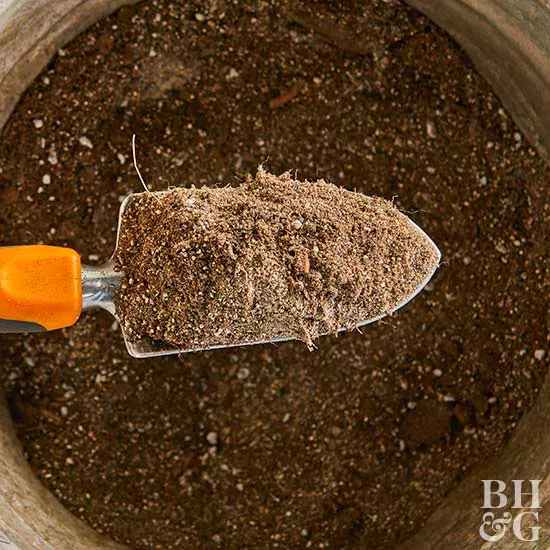All gardens benefit from regular additions of soil amendments and soil nutrients. Most soils do not provide ideal growing conditions for all plants right away. A soil amendment is a material added to soil to improve its physical nature. For example, some soils drain poorly. Others are too tightly compacted, so vital nutrients don't reach plant roots. This is where soil amendments can help.
Apply amendments individually or in combination each season and whenever you plant. For compost, manure, and peat, spread it 3 inches deep on top of soil and work in to the top 3 to 6 inches. For sand, greensand, vermiculite, perlite, or gypsum, apply 1/2 inch or less and work it into the top 8 inches of soil.
The following materials help improve soil's fertility and its capacity to hold or drain moisture, depending on your needs.
Editor's Tip: Excercise caution when working with powdery minerals. Do not breathe the dust, and avoid working with these substances on windy days. Tamp down the particles with water after applying.
Soil Amendments: Compost
Compost is made up of decomposed leaves, grass clippings, plant-based kitchen scraps, and other organic materials. It's a gardener's gold, as it makes a well-balanced, slow-release, nutrient- and humus-rich amendment. Garden soil compost helps lighten heavy soil and enrich poor soil. Plus, it's a cost-effective option since you can make it yourself for free.
Learn how to make your own compost.
Soil Amendments: Sand
Use coarse sand in small amounts to improve drainage and loosen clay soil. Don't overdo it though; too much sand turns some soils into concrete. It contains no nutrients but lasts indefinitely, so it doesn't need to be replaced.
Soil Amendments: Manure
Aged or rotted manure (from cows, sheep, horses, chickens, and others) boosts soil nitrogen. It loosens heavy soil and improves water retention in light soils. Fresh manure burns plants, so you should compost it for a year before using.
Soil Amendments: Peat
Peat absorbs moisture, which is especially helpful in sandy soil. It also loosens heavy or clay soils. If allowed to dry out though, it can become hard, crusty, and difficult to remoisten. Be mindful of environmental concerns: Peat or peat moss may be harvested from fragile peat bogs, a limited resource. Check labels and opt to use sphagnum peat moss instead.
Soil Amendments: Vermiculite and Perlite
Made by heating mica until it bursts, vermiculite is a lightweight particulate that holds moisture and loosens soil. Vermiculite works well in all soil types. It lasts indefinitely, so you only need to apply it once.
Vermiculite shown in lower right corner.
Similarly, perlite is a porous white volcanic residue that aerates soil, which is important to root growth and preventing soil compaction. The little "white specks" you see in many potting mixes are often perlite. It's good for all soil types; a little helps. It also lasts indefinitely and can be reused.
Perlite shown in upper left corner.
Soil Amendments: Greensand and Gypsum
Greensand is powdered rock made from the ocean mineral glauconite. This soil conditioner is high in potassium and other nutrients. It slows soil compaction and helps retain moisture. The characteristic greenish powder is popular among organic soil amendments.
Greensand shown in middle of left row.
Another powdered mineral used by gardeners, gypsum, is composed of calcium sulfate. (It can also be purchased in granular form.) As its name suggests, it adds calcium to your soil, which can help remedy salty soils, loosen heavy and clay soil, and improve drainage. However, it may not be appropriate for all gardens. A soil test is useful to see if you need to apply gypsum.
Gypsum shown in far back of left row.
Basic Nutrition in Plants
Plants need a balance of soil nutrients for healthy growth. Fertilizers, or complete plant foods, contain all of the basic macronutrients in soil: nitrogen, phosphorus, and potassium. Each chemical plays a vital role in plant development. For example, nitrogen promotes leaf and stem growth. Phosphorus encourages root growth, disease resistance, and flower color. Potassium assists in fruit and seed production. These nutrients are listed on packaged plant foods in percentages of N-P-K. If your soil is low in nutrients, don't fret. The following organic fertilizers, when added to soil, supply specific nutrients needed by plants.
Soil Nutrients: Nitrogen (N) Sources
- Alfalfa meal
- Blood meal
- Composted manure
- Cottonseed meal
- Feather meal
- Fish meal or emulsion
- Mushroom compost
- Rice hulls
Soil Nutrients: Phosphorus (P) Sources
- Bat guano
- Bonemeal
- Rock phosphate
Soil Nutrients: Potassium (K) Sources
- Dolomite lime
- Greensand
- Kelp meal
- Oyster-shell lime
- Rock dust
- Seaweed
- Wood ashes




















